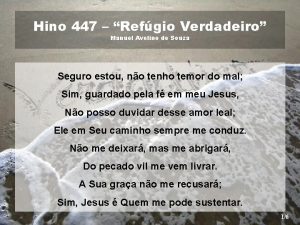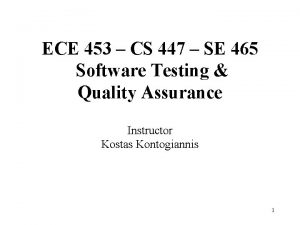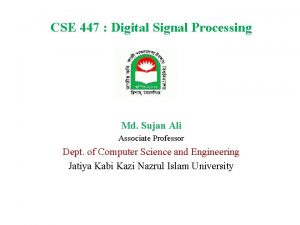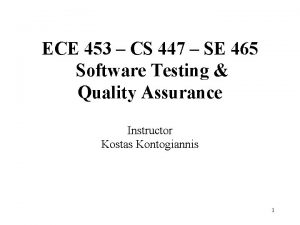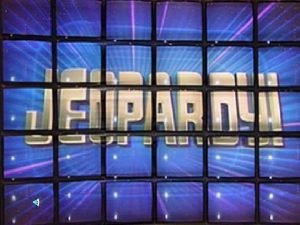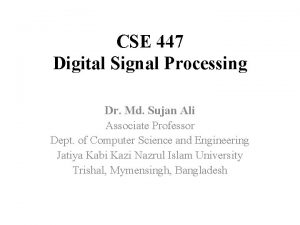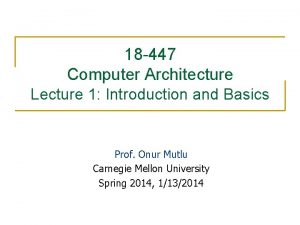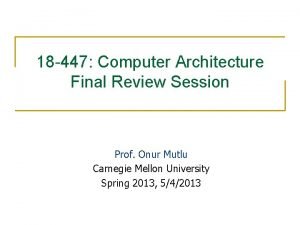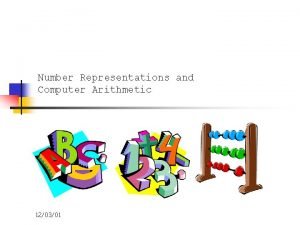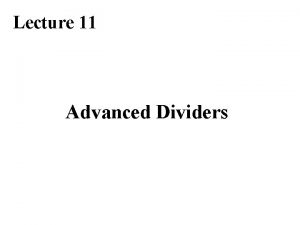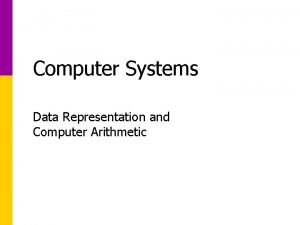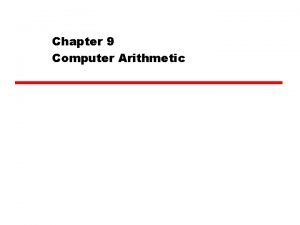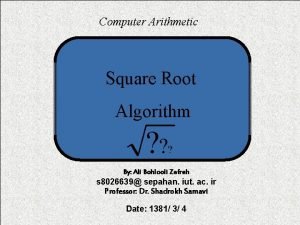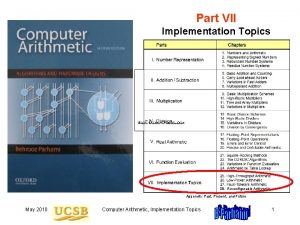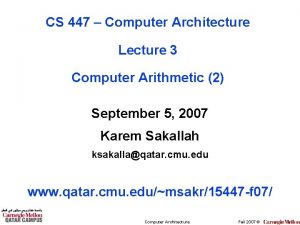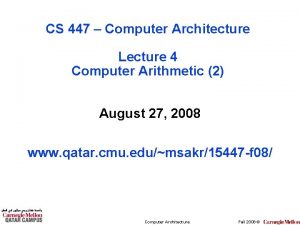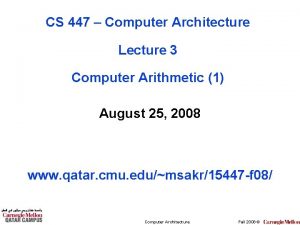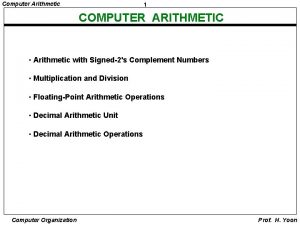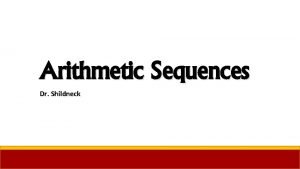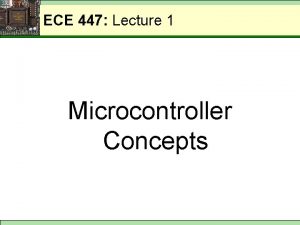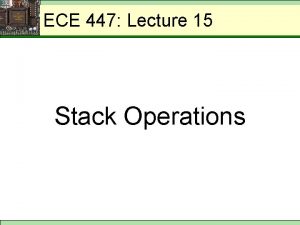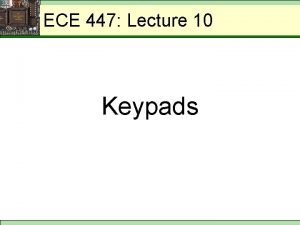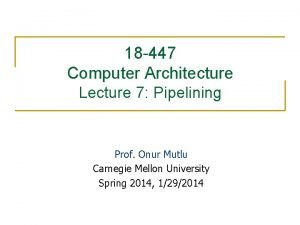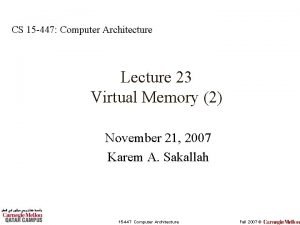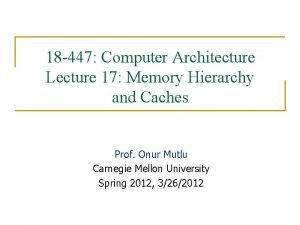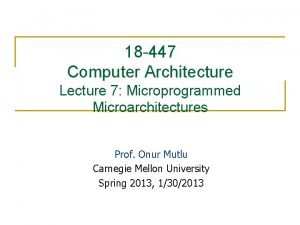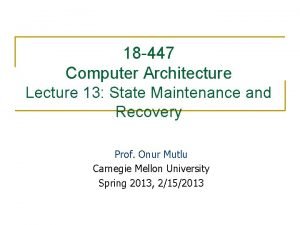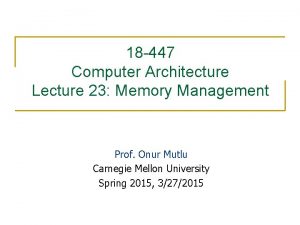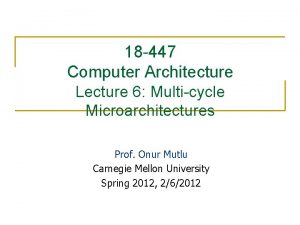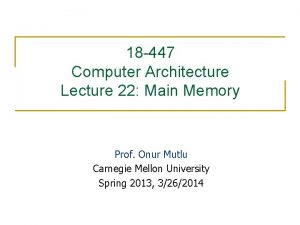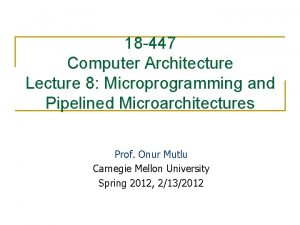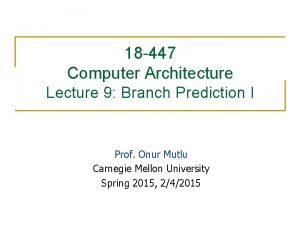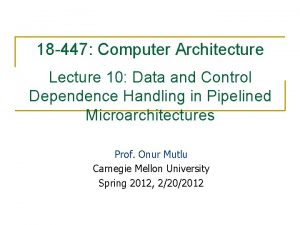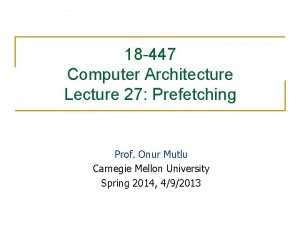CS 447 Computer Architecture Lecture 2 Computer Arithmetic





























- Slides: 29

CS 447 – Computer Architecture Lecture 2 Computer Arithmetic (1) August 29, 2007 Karem Sakallah ksakalla@qatar. cmu. edu www. qatar. cmu. edu/~msakr/15447 -f 07/ Computer Architecture Fall 2007 ©

Chapter objectives In this lecture we will focus on the representation of numbers and techniques for implementing arithmetic operations. Processors typically support two types of arithmetic: integer, or fixed point, and floating point. For both cases, the lecture first examines the representation of numbers and then discusses arithmetic operations. Computer Architecture Fall 2007 ©

Arithmetic & Logic Unit ° Does the calculations ° Everything else in the computer is there to service this unit ° Handles integers ° May handle floating point (real) numbers ° May be separate (maths co-processor) Computer Architecture Fall 2007 ©

ALU Inputs and Outputs Computer Architecture Fall 2007 ©

Review: Decimal Numbers ° Integer Representation • number is sum of DIGIT * “place value” d 7 d 6 d 5 d 4 d 3 d 2 d 1 d 0 Range 0 to 10 n - 1 0 0 3 7 9 2 107 106 105 104 103 102 101 100 379210 = 3 103 + 7 102 + 9 = 3000 + 700 + 90 + 2 Computer Architecture 101 + 2 100 Fall 2007 ©

Review: Decimal Numbers ° Adding two decimal numbers • add by “place value”, one digit at a time 3792 + 531 ? ? ? 1 3 7 9 2 + 0 5 3 1 0 4 3 2 3 Computer Architecture “carry 1” because 9+3 = 12 Fall 2007 ©

Binary Numbers • Humans can naturally count up to 10 values, but computers can count only up to 2 values (0 and 1) • (Unsigned) Binary Integer Representation “base” of place values is 2, not 10 b 7 b 6 b 5 b 4 b 3 b 2 b 1 b 0 0 1 1 0 0 27 26 25 24 23 22 21 20 011001002 = 26 + 25 + 22 = 64 + 32 + 4 = 10010 Computer Architecture Range 0 to 2 n - 1 Fall 2007 ©

Binary Representation If a number is represented in n = 8 -bits Value in Binary: a 7 a 6 a 5 a 4 a 3 a 2 a 1 a 0 Value in Decimal: 27. a 7 + 26. a 6 + 25. a 5 + 24. a 4 + 23. a 3 + 22. a 2 + 21. a 1 + 20. a 0 Value in Binary: an-1 an-2 … a 4 a 3 a 2 a 1 a 0 Value in Decimal: 2 n-1. an-1 + 2 n-2. an-2 + … + 24. a 4 + 23. a 3 + 22. a 2 + 21. a 1 + 20. a 0 Computer Architecture Fall 2007 ©

Binary Arithmetic ° Add up to 3 bits at a time per place value • A and B • “carry in” carry-in bits A bits B bits 1 1 1 0 0 1 1 1 0 + 0 1 1 1 sum bits carry-out bits 0 1 1 1 0 ° Output 2 bits at a time B • sum bit for that place value • “carry out” bit (becomes carry-in of next bit) ° Can be done using a function with 3 inputs, 2 outputs Computer Architecture carry out A FA sum Fall 2007 © carry in

Integer Representation ° Only have 0 & 1 to represent everything ° Positive numbers stored in binary • e. g. 41=00101001 ° No minus sign ° No period ° Sign-Magnitude ° Two’s complement Computer Architecture Fall 2007 ©

Sign-Magnitude ° Left most bit is sign bit Problems: ° 0 means positive sign and magnitude in ° 1 means negative arithmetic ° +18 = 00010010 • Two representations of ° -18 = 10010010 • Need to consider both zero (+0 and -0) Computer Architecture Fall 2007 ©

Two’s Complement ° +3 = 00000011 ° -3 = 11111101 ° +2 = 00000010 ° -2 = 11111110 ° +1 = 00000001 ° -1 = 1111 ° +0 = 0000 ° -0 = 0000 Computer Architecture Fall 2007 ©

Two’s Complement If a number is represented in n = 8 -bits Value in Binary: a 7 a 6 a 5 a 4 a 3 a 2 a 1 a 0 Value in Decimal: 27. a 7 + 26. a 6 + 25. a 5 + 24. a 4 + 23. a 3 + 22. a 2 + 21. a 1 + 20. a 0 ° +3 = 00000011 ° -3 = 11111101 ° +2 = 00000010 ° -2 = 11111110 ° +1 = 00000001 ° -1 = 1111 ° +0 = 0000 ° -0 = 0000 Computer Architecture Fall 2007 ©

Benefits ° One representation of zero ° Arithmetic works easily (see later) ° Negating is fairly easy • 3 = 00000011 • Boolean complement gives 11111100 • Add 1 to LSB 11111101 Computer Architecture Fall 2007 ©

2's complement ° Only one representation for 0 ° One more negative number than positive numbers -1 -2 -3 1111 1110 0 0001 1101 +1 0010 +2 + -4 1100 0011 +3 0 100 = + 4 -5 1011 0100 +4 1 100 = - 4 -6 1010 0101 1001 -7 0110 1000 -8 0111 +5 - +6 +7 Computer Architecture Fall 2007 ©

Geometric Depiction of Two’s Complement Integers Computer Architecture Fall 2007 ©

Negation Special Case 1 ° 0= 0000 ° Bitwise NOT 1111 ° Add 1 to LSB ° Result +1 1 0000 ° Overflow is ignored, so: °- 0 = 0 Computer Architecture Fall 2007 ©

Negation Special Case 2 ° -128 = 10000000 ° bitwise NOT 01111111 ° Add 1 to LSB ° Result +1 10000000 ° So: ° -(-128) = -128 X ° Monitor MSB (sign bit) ° It should change during negation Computer Architecture Fall 2007 ©

Range of Numbers ° 8 bit 2’s complement • +127 = 01111111 = 27 -1 • -128 = 10000000 = -27 ° 16 bit 2’s complement • +32767 = 011111111 = 215 - 1 • -32768 = 100000000 = -215 Computer Architecture Fall 2007 ©

Conversion Between Lengths ° Positive number pack with leading zeros ° +18 = 00010010 ° +18 = 0000 00010010 ° Negative numbers pack with leading ones ° -18 = 10010010 ° -18 = 1111 10010010 ° i. e. pack with MSB (sign bit) Computer Architecture Fall 2007 ©

Addition and Subtraction ° Normal binary addition ° Monitor sign bit for overflow ° Take two’s complement of subtrahend add to minuend • i. e. a - b = a + (-b) ° So we only need addition and complement circuits Computer Architecture Fall 2007 ©

Binary Subtraction ° 2’s complement subtraction: add negative 5 - 3 = 2 0101 0 1 +1 1 0011 flip 1100 +1 1101 1 0 0 1 0 -3 in 2’s complement form 3 - 5 = -2 0011 2 ignore overflow 0 0 1 1 +1 0 1 1 0101 flip 1010 +1 1011 1 0 -5 in 2’s complement form 0001 flip 0010 +1 -2 (flip+1 also gives positive of negative number) Computer Architecture Fall 2007 ©

Hardware for Addition and Subtraction Computer Architecture Fall 2007 ©

Multiplication ° Complex ° Work out partial product for each digit ° Take care with place value (column) ° Add partial products Computer Architecture Fall 2007 ©

Multiplication Example ° ° 1011 Multiplicand (11 dec) x 1101 Multiplier ° ° (13 dec) 1011 Partial products 0000 Note: if multiplier bit is 1 copy ° 1011 multiplicand (place value) ° 1011 otherwise zero ° 10001111 Product (143 dec) ° Note: need double length result Computer Architecture Fall 2007 ©

Unsigned Binary Multiplication Computer Architecture Fall 2007 ©

Execution of Example Computer Architecture Fall 2007 ©

Flowchart for Unsigned Binary Multiplication Computer Architecture Fall 2007 ©

Multiplying Negative Numbers ° This does not work! ° Solution 1 • Convert to positive if required • Multiply as above • If signs were different, negate answer ° Solution 2 • Booth’s algorithm Computer Architecture Fall 2007 ©
 Computer architecture lecture notes
Computer architecture lecture notes Isa definition computer
Isa definition computer Hino seguro estou não tenho temor do mal
Hino seguro estou não tenho temor do mal Ideiglenes mérőhely kialakítás
Ideiglenes mérőhely kialakítás Cs 447
Cs 447 Dr sujan ali
Dr sujan ali 450 onluğa yuvarlama
450 onluğa yuvarlama Who ordered the parthenon to be built
Who ordered the parthenon to be built Se 465
Se 465 Prime factorization of 447
Prime factorization of 447 What is z?
What is z? 18-447
18-447 Fces
Fces 01:640:244 lecture notes - lecture 15: plat, idah, farad
01:640:244 lecture notes - lecture 15: plat, idah, farad Bus design in computer architecture
Bus design in computer architecture Difference between architecture and organization
Difference between architecture and organization Flow chart for interrupt cycle
Flow chart for interrupt cycle Fftooo
Fftooo Computer arithmetic
Computer arithmetic Behrooz parhami computer arithmetic
Behrooz parhami computer arithmetic Data representation and computer arithmetic
Data representation and computer arithmetic Computer arithmetic
Computer arithmetic Square root algorithm
Square root algorithm William stallings computer organization and architecture
William stallings computer organization and architecture Computer arithmetic
Computer arithmetic Computer security 161 cryptocurrency lecture
Computer security 161 cryptocurrency lecture Computer aided drug design lecture notes
Computer aided drug design lecture notes Cycle
Cycle Call and return architecture
Call and return architecture Product architecture design
Product architecture design


